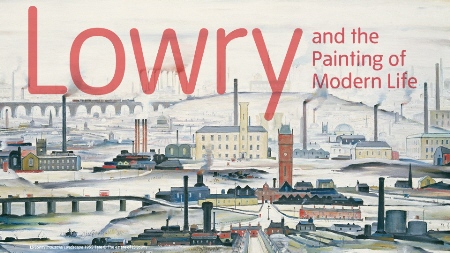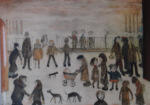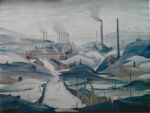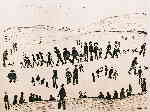01623-799-309
L.S. Lowry
Most limited edition prints illustrated are in stock and well below gallery retail prices!
The artist L.S. Lowry who died in 1976 aged eighty eight was 51 years old before he was nationally recognised as an outstanding British artist.
Known widely as 'The Lancashire Painter', he was in fact, the painter of an era.
That era was the industrial Lancashire and Cheshire of the 1914-18 war, which he interpreted so powerfully and individually that a visitor to an exhibition
of his works saw the streets outside the gallery through Lowry's eyes.
There was little literal truth in his paintings. Their power was due to a deeper artistic truth.
Yet he himself claimed to be a painter of what he saw, as indee he was. It was the way in which he transmuted what he saw that made his paintings unique.
Modern Lancashire hardly attracted him
Asked how he would set about painting Lancashire of the 1960s, he replied; 'My dear sir, I would not try.'
If he was not entirely free from some bitterness over long delayed recognition, he was not soured by it.Perhaps out of a desire to see that young painters
should not suffer his fate, he was always eager to stress their merits.
Early Ambition
Laurence Stephen Lowry was born at Old Trafford, Manchester, only son of R.S.M. Lowry an estate agent, and Elizabeth Hobson. He realized early in life that he wished to paint,
though from his mother he inherited a love of music.
Later the family moved to Rusholme, and in 1909 to Pendlebury, a move that was to have great significance for Lowry as a painter. There he remained until 1948,
his father having died in 1932 and his mother in 1939.
Lowry himself moved to Mottram-in-Longdendale, Cheshire, but paid constant visits to his youthful sketching ground.
He studied at Manchester College of Art and Design, and at the Peel Park Technical College, Salford. In 1918 he became a student of the Manchester Academy of Fine Arts,
of which he subsequently became an honarary member after first exhibiting in 1932.
In Lowry's student drawings, many of which were seen at Salford City Art Gallery, there was little, if any, suggestion of the artist that was to be. In fact,
it was the accident of missing a train to Manchester from Pendlebury in 1916 that set him on the road that won him belated acclaim.
He left the station and wandering round the streets, found his first inspiration for the work of a lifetime in a tall spinning mill.
But until he had his first London exhibition at Lefevre Gallery in 1939, he was practically unknown outside the Manchester area.
But there, his was a different story. Manchester City Art Gallery bought its first Lowry, 'An Accident' (in fact a suicide), set in Pendlebury in 1926,
the first of his paintings to enter a public collection and later acquired several more.
Salford had also begun building up what is now one of the finest collections of Lowry's work in the country. More exhibitions in London followed and interest in his work grew.
The Tate Gallery bought a painting and his work entered the Royal Collection.
In 1955 Lowry became an A.R.A. and in 1962 was elected R.A. Manchester University made him an A.R.A. and in 1962 was elected R.A.
Manchester University made him an honorary M.A. and L.L.D.
He became a Freeman of Salford in 1965
Important retrospective exhibitions were held at Salford in 1941 and 1951, at Wakefield in 1955, Manchester in 1959, Sheffield in 1962 and Abbot Hall art gallery 1964.
These culminated in the Art's Council's large retrospective exhibition at the Tate Gallery in November, 1966.
In 1964 a special birthday concert was given by the Halle Orchestra at the Free Trade Hall Manchester.
Lowry remained steadfastly faithful to the Northern scene.
Though in the 1960s he found new stimulus in Sunderland and Newcastle and produced some rather whimsical paintings like 'The Carriage' bought by the Queen in 1962,
it was in close contact with the Manchester area that he produced his most memorable work.
In February 1971, he paid one of his rare visits to London for the opening of an exhibition of 60 of his drawings at the Lefevre Gallery, Bruton Street.
He lived alone and was often referred to as 'The Lonely Painter.' Perhaps he was, but on the other hand, no man appeciated the independence and freedom of the solitary
existence better than this provincial master who won himself a place in the history of English art.
Lowry signed Prints and Lithographs.
There are approximately 54 signed Lowry prints (signed, limited edition print titles) by and 17 lithographic prints.
Approximately 26 unsigned,
Lowry limited edition prints.
Numerous open edition, poster prints of decorative not numbered or personally signed, of decorative value only, were published.
The
signed prints usually have an embossed stamp, by the Fine art trade guild, or that of the publisher.
Some print titles are simply signed by the artist and numbered.
Several print titles eg. 'Mill scene' print, 'Level crossing' print, and 'Market scene' print are simply signed in pencil by L.S. Lowry.
But not stamped or numbered, although they are limited edition prints (editions of 750).
Lowry both liked and understood these industrial areas, he had no need to travel abroad, journeying from one side of the city to the other gave him all the depth he required
for his paintings. One of his first reviewers, Bernard Taylor, commented in 1921. Lowry's portrait of Lancashire is more grimly like that of a caricature, because it is done
with the intimacy of affection.
He emphasises violently everything that industrialism has done to make the aspect of Lancashire more forbidding than that of most other places. Many of us may comfort
ourselves a little with contemplating suburban roads, parks, or gardens in public squares, or with the lights and colours of morning or sunset. L.S.Lowry has refused
all comfortable delusions.
Lowry has kept his vision as fresh as if he had come suddenly into the most forbidding part of Hulme or Ancoats under the gloomiest skies after a holiday in France or Italy'
The life and work of L.S.Lowry Salford's artist
Laurence Stephen Lowry began life in Rusholme, Manchester, November 1887, the only child of Mr R S Lowry from Ireland and his wife Elizabeth (maiden name; Hobson).
He attended a neighborhood school in Victoria Park, but took private classes from William Fitz, before begining his work as a clerk for an agency of chartered accountants in 1904,
that would show him the many sights he would later use for his paintings.
From 1905-1915 Lowry attended drawing and painting courses at the Municipal College of Artwork (later Manchester College of Art, now a part of Manchester Metropolitan
University), where Lowry was tutored by the now well known an highly regarded artist, Adolphe Valette.
He moved to Pendlebury in Salford together with his parents in 1909, for almost forty years Lowry lived here. Throughout this time Lowry attended art classes at Salford
School of Art, growing a strange, almost morbid curiosity for the city and industrial landscape.
Lowry was fascinated by its people, who toiled night and day against incredible odds, to make a living for themselves, working long hours in terrible conditions,
with little to show financially. Large families living in small terrace houses with barely sufficient food, and the Fever Van never far away.
Lowry exhibited with the Manchester Academy of Fine Arts from 1919, as well as showing paintings in the Paris Salon.
By the early 1930s Lowry was exhibiting at the 'Royal Academy', London, and was awarded an honorary Master of Art at Manchester College in 1945, and Doctor of Letters in 1961.
In 1962 he was elected to the Royal Academy, and given freedom of the City of Salford in 1965.
He lived in Mottram till he died in 1976; the people of Manchester showed an unprecedented homage to this great master of art.
L.S. Lowry is without doubt, one of the most celebrated of British artists and his unique contribution to recording the interval, tradition and panorama of commercial Salford
and Manchester is without parallel.
His work is a most distinctive and comprehensive report of the pre and post World War Two northern industrial towns. Many people affiliate Lowry with "matchstick figures",
but he's recognized to have produced over 10,000 works, ranging from completed oil paintings to swiftly drawn sketches.
The local industrial scenes were his most frequent topics but he additionally painted seascapes and portraits. Lowry was an amazing humorist and had intense insight into human
nature, characterising it without sentiment. Later in his life Lowry worked on producing paintings of figures either singly or collectively, invariably in opposition to a white
background.
Throughout his lifetime, he also produced thousands of pencil drawings, these have become very collectable and the most detailed ones are very professionally drawn.
Lowry was not registered with any doctor; in 1976 he died at hospital from pneumonia.
He had little time for the financial sharks that would 'hound' him on a daily basis, and the galleries hoping to inherit a number of works in Lowry's will, they kept in close
contact with him throughout his old age, only to learn that Lowry had left all his paintings to a lady, with the same surname (Carol Ann), who had written him a letter when
she was a young girl, asking how she may learn to be an artist.
His standing as one of the foremost British artists of the 20th Century was strengthened when the painting "Going To The Match" was sold for a record
£1.9 million to the Manchester based 'Professional Footballers Association'.
Manchester's newly built museum gallery, The Centre in Salford Quays, now holds a major collection of his work.
There is to be a major exhibition of paintings and drawings by L.S Lowry in The Tate Gallery 2013.
But Lowry agreed to only fifty four signed prints, and each title ranged from 95 to 850 in the edition. (75 in the case of the lithograph signed prints)
Once the signed prints had been published, the work was copyrighted and the original printing plates were destroyed so that apart from the original painting
only the agreed number of signed prints were produced.
Needless to say that after 50 or so years , from an edition of 850, there are a mere fraction of the edition that still exists in good condition.
Many will have been lost damaged (often by the glass breaking), being stored in damp conditions or the case of several titles,
fading, due to the printers who have not used the lightfast inks and acid free paper.
Our gallery in the East Midlands
diplays over 100 limited edition prints, personally signed by Mr L.S. Lowry, undoubtedly the largest collection in the UK.
Some interesting facts regarding L.S.Lowry's paintings;-
Paintings, drawings and signed prints by L S Lowry have become some of the most sought after art work in the country today.
Through the use of paint, canvas and pencil, this artist from the Manchester area in Lancashire, has managed to capture with
remarkable accuracy and with direct, honest and a truthful vision, the spirit of a moment in time that has long since disapperared.
Lowry shows the profound sadness and hardship endured by Lancashire's inhabitants on a daily basis, in a way that we can understand
and have a greater insight to this strange and almost toturous way of life.
We can see from a few examples how the price of L.S. Lowry paintings and signed prints have dramatically increased over the years.
" A painting recently sold for ten times the original price"
The Thames from Whitehall Court (22" x 26" oil on canvas), sold for £520,000
Although less sought after than Lowry's views of the northern industrial areas,
this work made a large return for the vendor when purchased in 1987 for £22,000.
An increase of x 23.5 over the 22 year period indicates that it has been a superb investment
and the returns were far in excess of both the FTSE 100 and the property market.
The highest price for one painting was £1.9 million when 'Going To The Match' was sold in 1999.
Later in 2007, the sale of the Lowry's painting "Daisy Nook Fair" achieved £3.8m.
May, 2011 "The Football Match" painting (not 'Going to the match') by Lowry was sold for £5,641,250.
November, 2011 The 1960 painting of 'Piccadilly Circus' by L.S.Lowry was sold for £5,641,250
Recently the 'Going to the Match' painting has been valued at £6,000,000-10,000,000

Major Lowry Exibition at the Tate Gallery, London 26th June - 20th October, 2013
Our aim is to offer our clients an excellent service at unbeatable prices.








